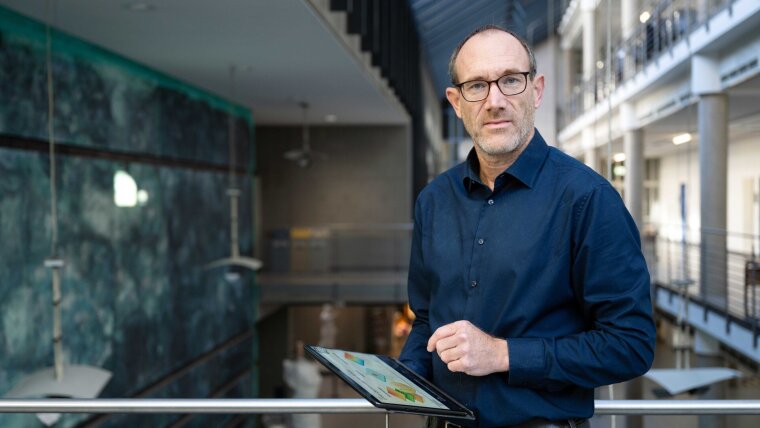
Published: | By: Sebastian Hollstein
Source article
Scientists are increasingly using artificial intelligence to observe our earth system. This makes it possible, for example, to predict the weather more accurately or warn of natural events such as flooding. However, our planet and the processes taking place on it are too complex for most AI models—especially when they are changing as rapidly as they are due to climate change.
A research team from Friedrich Schiller University Jena, Jena University Hospital (JUH), the Max Planck Institute for Biogeochemistry in Jena and the Senckenberg Institute for Plant Form and Function in Jena therefore wants to develop AI models that function reliably under constantly changing conditions. As the Carl-Zeiss-Stiftung has now announced, it is supporting the new project »AI Generalizability in Non-stationary Environmental Regimes: The Case of Hydro-climatic Extremes (GENAI-X)« as part of its funding programme »CZS Breakthroughs« for five years with a total of around six million euros. The project originates from the ELLIS Unit JenaExternal link, which is part of the pan-European AI network of excellence »European Laboratory for Learning and Intelligent Systems«.
Predicting landslides
In their project, the Jena researchers are combining two strands of work: firstly, they want to fundamentally develop AI-based methods so that they can be used in complex and changing environmental systems. Secondly, the scientists want to test these new models in practical environmental research—particularly in the context of extreme hydro-climatic events such as floods, droughts or landslides.
»In contrast to many other areas of application, an AI model used for such applications should not be based exclusively on data from past events, but should also take into account changing conditions and mechanisms of action in space or over time«, explains Prof. Dr Alexander Brenning, who is coordinating the project at the University of Jena. Such generalisability of AI systems helps, for example, to develop models that function independently of specific locations or without temporal restrictions.
For example, they could be used to predict landslides in a certain area based on similar events in other regions with better data. Or they should be able to predict the risk of a landslide in a specific region, not only based on local conditions during past events of this type, but also taking into account, for example, changes in land use or changes in environmental conditions such as the frequency or intensity of heavy rainfall events.
Combining environmental processes and artificial intelligence
The team, which consists of both geoscientists and computer science experts, combines various AI methods for its work. »We are pursuing a hybrid modelling approach in which we combine AI with physical, hydrological or ecological laws, for example«, explains the Jena geoinformatics expert. »Current AI can recognize patterns, but does not understand why something is happening and is therefore unreliable when the data is sparse or the framework conditions change. Physical models are based on vast amounts of parameters that are usually incompletely known, which limits their predictive power. If both approaches are combined, the AI receives physical guard rails for its calculations and can fill the gaps left by missing parameters in the physical models.«
Equally promising are causal AI models that not only extract statistical correlations from data, but also derive cause-and-effect relationships. To do this, researchers correlate variables—such as how ecosystems change during drought—and describe these relationships using mathematical rules, thus obtaining more reliable statements about possible consequences. The »discovering« of mathematical relationships through so-called symbolic regression also falls into this category. It attempts to mould hidden relationships into clear formulas that are easier to interpret and verify.
The project also includes dimension reduction, for example, in which AI models crystallize the key factors that are decisive for the respective questions from multi-layered data sets—such as satellite images, on-site observation of plant growth and sensor data.
Better early warning systems
The Jena team is closely networked with partners from science and practice, such as the German Centre for Integrative Biodiversity Research (iDiv)External link, the Centre for Medium-Range Weather Forecast (ECMWF)External link and GeoSphere Austria—Federal Institute for Geology, Geophysics, Climatology and Meteorology. This networking helps to test the new models in an application-oriented manner and to provide impetus beyond the project. In this way, the researchers are helping to develop better early warning systems for certain disasters. New AI systems can also be used to recognize sources of danger at an early stage, enabling timely countermeasures to be taken. For example, certain areas could be reforested in a targeted manner to prevent the dangers of landslides.
About the Carl-Zeiss-Stiftung
The Carl-Zeiss-StiftungExternal link has set itself the goal of creating scope for scientific breakthroughs. As a partner of excellent science, it supports both basic research and application-oriented research and teaching in the STEM departments (science, technology, engineering and mathematics). Founded in 1889 by the physicist and mathematician Ernst Abbe, the Carl-Zeiss-Stiftung is one of the oldest and largest private science-promoting foundations in Germany. It is the sole owner of Carl Zeiss AG and SCHOTT AG. Its projects are financed from the dividends distributed by the two foundation companies.
Contact:
Monday 4 - 6 pm